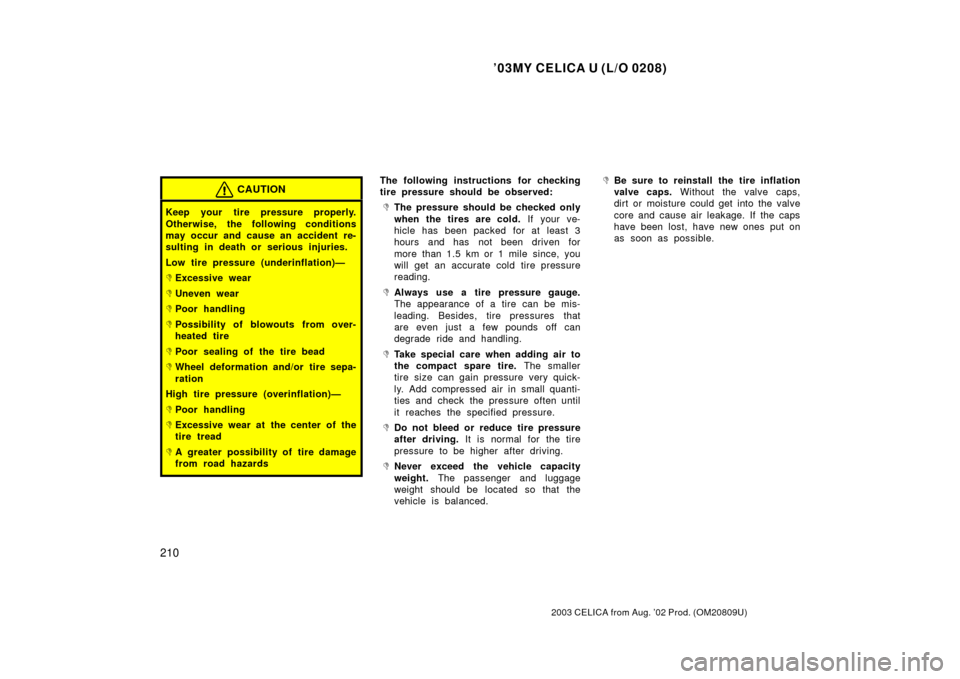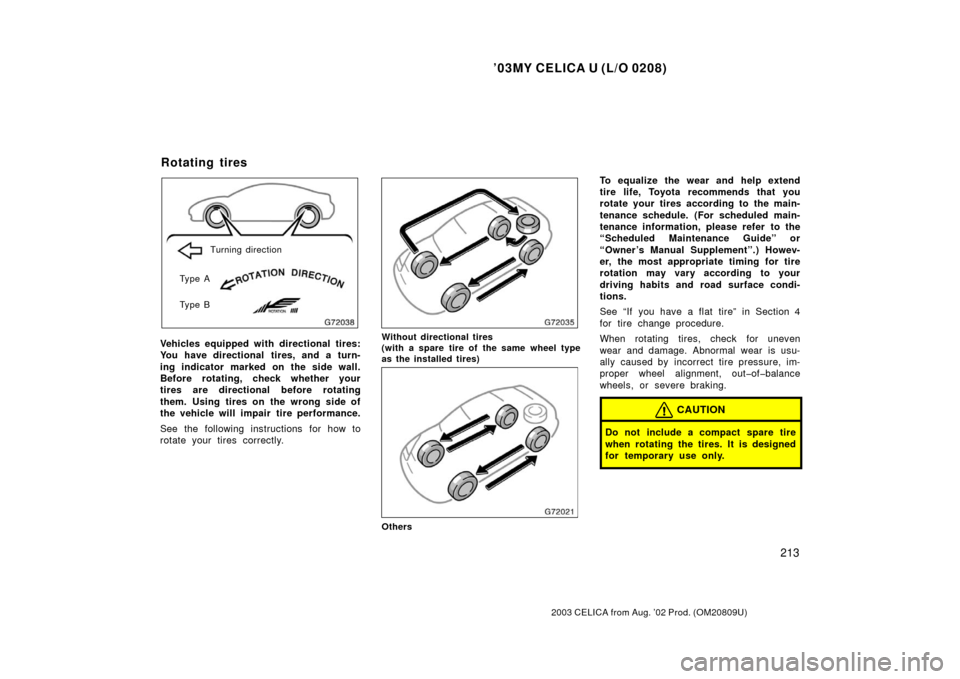Page 214 of 249

’03MY CELICA U (L/O 0208)
210
2003 CELICA from Aug. ’02 Prod. (OM20809U)
CAUTION
Keep your tire pressure properly.
Otherwise, the following conditions
may occur and cause an accident re-
sulting in death or serious injuries.
Low tire pressure (underinflation)—
�Excessive wear
�Uneven wear
�Poor handling
�Possibility of blowouts from over-
heated tire
�Poor sealing of the tire bead
�Wheel deformation and/or tire sepa-
ration
High tire pressure (overinflation)—
�Poor handling
�Excessive wear at the center of the
tire tread
�A greater possibility of tire damage
from road hazards
The following instructions for checking
tire pressure should be observed:
�The pressure should be checked only
when the tires are cold. If your ve-
hicle has been packed for at least 3
hours and has not been driven for
more than 1.5 km or 1 mile since, you
will get an accurate cold tire pressure
reading.
�Always use a tire pressure gauge.
The appearance of a tire can be mis-
leading. Besides, tire pressures that
are even just a few pounds off can
degrade ride and handling.
�Take special care when adding air to
the compact spare tire. The smaller
tire size can gain pressure very quick-
ly. Add compressed air in small quanti-
ties and check the pressure often until
it reaches the specified pressure.
�Do not bleed or reduce tire pressure
after driving. It is normal for the tire
pressure to be higher after driving.
�Never exceed the vehicle capacity
weight. The passenger and luggage
weight should be located so that the
vehicle is balanced.
�Be sure to reinstall the tire inflation
valve caps. Without the valve caps,
dirt or moisture could get into the valve
core and cause air leakage. If the caps
have been lost, have new ones put on
as soon as possible.
Page 215 of 249

’03MY CELICA U (L/O 0208)
211
2003 CELICA from Aug. ’02 Prod. (OM20809U)
Tread wear indicator
CHECKING YOUR TIRES
Check the tire tread for the tread wear
indicators. If the indicators show, re-
place the tires.
The tires on your Toyota have built�in
tread wear indicators to help you know
when the tires need replacement. When
the tread depth wears to 1.6 mm (0.06
in.) or less, the indicators will appear. If
you can see the indicators in two or more
adjacent grooves, the tire should be re-
placed. The lower the tread, the higher
the risk of skidding.Vehicles equipped with 205/50R16 tires:
Your Toyota has been fitted with specially
developed tires which provide exceptional
dynamic performance under general road
conditions. However your riding comfort
may worsen a little and road noise may
increase during driving. You may also no-
tice that your tires will wear more rapidly
and tire grip performance will be reduced
on the snowy and/or icy roads when
compared to standard tires. Be sure to
have snow tires or tire chains on the
snowy and/or icy roads and drive carefully
with the speed appropriate for road condi-
tions.
NOTICE
Low profile tire like 205/50R16 may
have greater damage than usual tires
to its tire wheel when receiving im-
pact from the road surface. Therefore,
pay attention to the following.
�
Be sure to use with proper tire
pressure. If the tire pressure is low,
the tire may have a greater damage.
For detailed information about tire
pressure, see Section 8.
� Avoid driving onto high, sharp�
edged objects and other road haz-
ards. Failure to do so can lead to
severe tire damage.
The effectiveness of snow tires is lost
if the tread wears down below 4 mm
(0.16 in.).
Checking and replacing tires
Page 217 of 249

’03MY CELICA U (L/O 0208)
213
2003 CELICA from Aug. ’02 Prod. (OM20809U)
Ty p e A
Ty p e BTurning direction
Vehicles equipped with directional tires:
You have directional tires, and a turn-
ing indicator marked on the side wall.
Before rotating, check whether your
tires are directional before rotating
them. Using tires on the wrong side of
the vehicle will impair tire performance.
See the following instructions for how to
rotate your tires correctly.Without directional tires
(with a spare tire of the same wheel type
as the installed tires)
Others
To equalize the wear and help extend
tire life, Toyota recommends that you
rotate your tires according to the main-
tenance schedule. (For scheduled main-
tenance information, please refer to the
“Scheduled Maintenance Guide” or
“Owner ’s Manual Supplement”.) Howev-
er, the most appropriate timing for tire
rotation may vary according to your
driving habits and road surface condi-
tions.
See “If you have a flat tire” in Section 4
for tire change procedure.
When rotating tires, check for uneven
wear and damage. Abnormal wear is usu-
ally caused by incorrect tire pressure, im-
proper wheel alignment, out�of�balance
wheels, or severe braking.
CAUTION
Do not include a compact spare tire
when rotating the tires. It is designed
for temporary use only.
Rotating tires
Page 241 of 249
’03MY CELICA U (L/O 0208)
237
2003 CELICA from Aug. ’02 Prod. (OM20809U)
Tire size and pressure:Model
Tire size
Tire pressure
kPa (kgf/cm2 or bar, psi)Wheel size
FrontRear
1ZZ�FE engine195/60R15 88H210 (2.1, 29)210 (2.1, 29)15 �61/2JJ
P195/60R15 87H210 (2.1, 29)210 (2.1, 29)15 �61/2JJ
2ZZ�GE engine
205/55R15 87V220 (2.2, 32)220 (2.2, 32)15 �61/2JJ
P205/55R15 87V220 (2.2, 32)220 (2.2, 32)15 �61/2JJ
205/50R16 87V220 (2.2, 32)220 (2.2, 32)16 �61/2JJ
Compact spare tire
Tire size
Tire pressure kPa (kgf/cm2 or bar, psi)Wheel size
T125/70D16 96M420 (4.2, 60)16�4T
Wheel nut torque, N·m (kgf·m, ft·Ibf):
103 (10.5, 76)
NOTE: For a complete information on tires (e.g. replacing tires or replacing wheels), see “Checking tire pressure” through “Alum inum
wheel precautions” in Section 7�2.
Tires
Page 249 of 249

’03MY CELICA U (L/O 0208)
2003 CELICA from Aug. ’02 Prod. (OM20809U)
Publication No. OM20809U
Part No. 01999-20809
Printed in Japan 01�0208�00
C
(U)
Quick index
�If a service reminder indicator or warning buzzer comes on 83 . . . . . . . . .
� If your vehicle will not start 160 . . . . . . . . . . . . . . . . . . . . . . . . . . . . . . . . . . . . .\
. .
� If your engine stalls while driving 163 . . . . . . . . . . . . . . . . . . . . . . . . . . . . . . . . . .
� If your vehicle overheats 164 . . . . . . . . . . . . . . . . . . . . . . . . . . . . . . . . . . . . .\
. . . . .
� If you have a flat tire 165 . . . . . . . . . . . . . . . . . . . . . . . . . . . . . . . . . . . . .\
. . . . . . . .
� If your vehicle needs to be towed 175 . . . . . . . . . . . . . . . . . . . . . . . . . . . . . . . . .
� Tips for driving during break�in period 134 . . . . . . . . . . . . . . . . . . . . . . . . . . . . .
� How to start the engine 148 . . . . . . . . . . . . . . . . . . . . . . . . . . . . . . . . . . . . .\
. . . . . .
� General maintenance 191 . . . . . . . . . . . . . . . . . . . . . . . . . . . . . . . . . . . . .\
. . . . . . . . .
� Complete index . . . . . . . . . . . . . . . . . . . . . . . . . . . . . . . . . . . . . . . . . . . . . . . . . . . . . . .
Gas station information
Fuel type:
1ZZ�FE engine: UNLEADED gasoline, Octane Rating 87
(Research Octane Number 91) or higher
2ZZ�GE engine: Premium UNLEADED gasoline, Octane Rating 91
(Research Octane Number 96) or higher
See page 134 for detailed information.
Fuel tank capacity:
55 L (14.5 gal., 12.1 lmp. gal.)
Engine oil:
API grade SL “Energy�Conserving” or ILSAC multigrade engine oil is
recommended.
See page 205 for detailed information.
Tire information: See pages 209 through 215.
Tire pressure: See page 237.
U�6